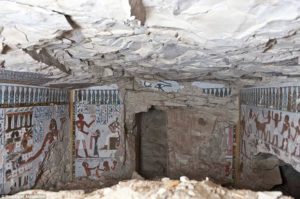In a breathtaking discovery, a team of American archaeologists discovered two beautiful ancient tombs in the southern city of Luxor belonging to Amenhotep, guard of the temple of Egyptian deity Amun, and his son.
It is a stunning find, considering how much attention and visitation the historic city of Luxor typically draws. The incredibly beautiful works displayed in the tombs demonstrate once again the majesty of the ancient Egyptians and their unequaled skill in creating gorgeous murals depicting scenes from Egyptian life.
According to the Antiques Minister, the tomb dates back to the New Kingdom of the 18th Dynasty (1543-1292 BC) — the most famous of ancient Egypt dynasties. They were found near the Sheikh Abd el-Qurna dig site at the feet of the Theban mountains, between the famed valleys of the Kings and Queens over the town of al-Qurna.
The ministry released breathtaking photographs showing the murals in the tombs—bright green and brown paintings with hieroglyphics showing both celebrations and everyday activity.
Despite their age, the tombs are still incredibly vibrant and colorful. But there was bad news accompanying the find. Antiquities Minister Mamdouh al-Damaty said in a statement that the tombs appear to have been looted at some point. The sarcophogi containing the bejeweled mummies were missing.
“The tomb contains many stunning scenes with bright colours painted on plaster,” Eldamaty said in a statement. “Many of scenes represent the tomb owner and his wife in front of an offering table and a view of a goddess nursing a royal child as well as scenes of the daily life.”
Sultan Eid, the ministry’s general director for the Upper Egypt region, said the T-shaped tomb was likely damaged deliberately in ancient times.
“The name and titles of the tomb owner, some hieroglyphic texts and scenes in addition to the names of the god Amun were deliberately erased,” Eid said.
The first tomb was discovered on March 2, and the second was discovered on March 10 by a team of American archaeologists alongside an Egyptian inspectors’ team in Luxor, 435 miles south of Cairo.

They share a courtyard with the Tomb of Djehuty, which, Discovery reported, was commissioned by a royal cupbearer for the pharaohs Hatshesut and Tuthmosis.
The murals, which have gashes, some large, that show they were obviously vandalized, were described this way:
* A god’s doorkeeper and his wife. The first tomb, which was discovered on March 2, belongs to an Amenhotep surnamed Rabiu, and his wife, Satamen. Amenhotep was a doorkeeper to the Egyptian god Amun.
* Amenhotep’s son and his wife. The second tomb was discovered March 10, and belongs to Sa-mut, the son of Amenhotep and Satamen, and his wife, Ta-Khaeet.
Tombs of the Nobles are the burial places of some of the powerful courtiers and persons of the ancient city.
These areas, according to touregypt.net, mostly lie in five different regions. Farthermost north is an area known as el-Tarif, where large, row tombs were dug during the late Second Intermediate Period and early Middle Kingdom.
Just south of el-Tarif is Dra Abu el-Naga, which is a hillside with about 80 numbered tombs mostly belonging to priests and officials of the 17th through 20th dynasty, including some rulers of the 17th dynasty.
Just southwest of Dra Abu el-Naga is an area called El-Assasif, where there are 40 tombs, mostly from the New Kingdom and later. Just south of El-Assasif is El-Khokha, a hill with five Old Kingdom tombs and 53 numbered tombs from the 18th and 19th dynasty.



